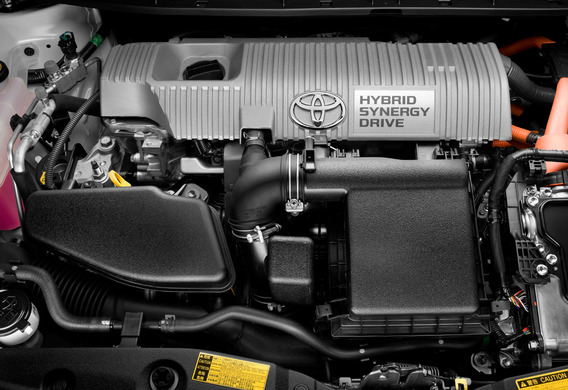
The sequence diagram of the hybrid drive is the simplest. In the case of successive builds, the internal combustion engine drives the shaft of the electric motor, which drives the driving wheels of the vehicle. Hybrid-drive system device
Hybrid-drive system device
An energy storage device, either in the form of a battery or a superconductor, is mounted between the drive engine and the generator. The drive is accumulating excess power generated by generator and recovery energy, providing high load on the wheels. Such a hybrid hybrid drive scheme provides an opportunity to stabilize the operating mode of the internal combustion engine at maximum fuel efficiency.
This hybrid drive scheme does not need to be chaining and gearbox gear, gear ratios and other elements of mechanics, since the engine does not have a mechanical link to the steered wheels, which makes it possible to apply any layout of the drive.
In addition, a regenerative braking that converts the vehicle's kinetic energy to electricity is also used in a sequential drive to recharge the battery.
The name of the "serial transmission" is because the resulting capacity along the path to the leading wheels passes the chain of successive transformations.
First, the mechanical energy from the internal combustion engine is generated and transformed into electrical energy from the generator and then goes into mechanical, driving the steering wheels.
In the process of transmission of energy in successive transmission, there is an inevitable loss of energy. At the same time, the internal combustion engine of small power can be used in a simple sequence of actuator. The power of the engine is continuously in the range of maximum efficiency, and it can be switched off at all if necessary.
At the time of the deactivation of the DBA, the electric motor battery is sufficient to create the necessary capacity to move the vehicle. But in this case, unlike the batteries for the DSS, the battery for hybrids needs more powerful batteries, and it has become more cost-effective.
The efficiency of a serial hybrid pattern is evident in frequent stops, accelerations and braking, and movement at a low speed, which is relevant to traffic in the city. Therefore, this successive hybrid drive scheme is most appropriate for urban transport and has been used, for example, in buses and other types of urban transport.
A consistent hybrid drive also has heavy duty dump trucks, where large wheel torque is required and there is no need for high traffic speeds.
Advantage and disadvantages of a hybrid hybrid drive
The shortcomings of the sequential hybrid drive are to include the double conversion of energy, which theoretically reduces its efficiency, as well as the necessity of using the power converter for the full power of the transmission. Besides, today the price for the set of traction equipment is quite high.
The movement in the extra-urban cycle at a steady speed when this pattern is not quite effective is also worth the consistent drive. Compensation of the extra-urban cycle in this case is the regenerative braking that is an contributor to the spent energy.
Hybrid cars, however, should not be assigned to cars, where all today's problems with toughening requirements for power installations have been solved. Such vehicles may be considered as a transitional stage in the development of vehicles with zero emissions of harmful substances for our planet.
However, hybrid technologies and the consistent hybrid drive in particular provide an opportunity to bring to perfecta key technical elements of future environmentally friendly cars. The hybrids have developed more capacitorized and compact batteries, reuses of used energy, new electric motors, and the possibility of rapid charging of new technology and light-weight vehicles.
Thus, the serial hybrid provides the possibility of connection after the end of the trip to the electric grid. Such vehicles have also been called the Plug-in Hybrid (or a plug-in hybrid). The use of such a function in a sequential drive involves the use of high capacity accumulators (lithium ion batteries), which minimises the use of the internal combustion engine, and thus decreases the emissions of harmful substances.
The Hybrid Hybrid family cars represent, for example, Opel Ampera, Chevrolet Volt, which has an increased range. They can move up to 60 km of battery power and the power of the generator from the power train up to 500 km.







